new posts in all blogs
Viewing: Blog Posts Tagged with: Tidal Homeschooling, Most Recent at Top [Help]
Results 1 - 8 of 8
How to use this Page
You are viewing the most recent posts tagged with the words: Tidal Homeschooling in the JacketFlap blog reader. What is a tag? Think of a tag as a keyword or category label. Tags can both help you find posts on JacketFlap.com as well as provide an easy way for you to "remember" and classify posts for later recall. Try adding a tag yourself by clicking "Add a tag" below a post's header. Scroll down through the list of Recent Posts in the left column and click on a post title that sounds interesting. You can view all posts from a specific blog by clicking the Blog name in the right column, or you can click a 'More Posts from this Blog' link in any individual post.
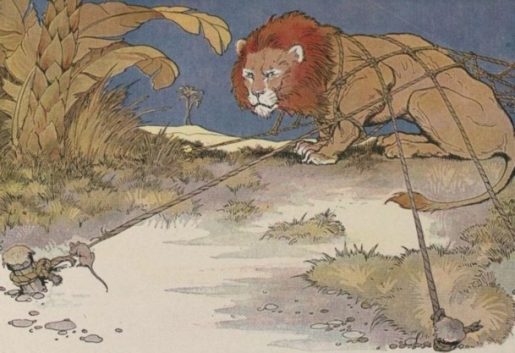
Milo Winter illustration from Aesop for Children
Things we’ve explored together so far this week:
Robert Browning’s “The Pied Piper” (first part)
Thomas Hood’s “A Parental Ode to My Son, Aged Three Years and Five Months” (a family favorite)
Aesop’s Fables—”Belling the Cat” and “The Lion and the Mouse”
Ace, the Very Important Pig by Dick King-Smith
The Jazz Age
Founding of Jamestown (teens and littles are on different history tracks)
Gustav Klimt—”The Kiss,” “Tree of Life” (and this art project)
Plus loads of Journey North prep! Our group’s big Mystery Class reveal party is tomorrow—one of my favorite events of the year.
I hopped on Periscope this afternoon for a quick Q&A about Journey North Mystery Class. If you’d like a peek at our graph (behind as usual) and a walk-through of the project, here you are.

By:
Melissa Wiley,
on 3/8/2016
Blog:
Here in the Bonny Glen
(
Login to Add to MyJacketFlap)
JacketFlap tags:
podcast,
Homeschooling,
author interviews,
Fun Learning Stuff,
tidal learning,
Pam Barnhill,
Author stuff,
Tidal Homeschooling,
Ed Snapshots,
Add a tag
Pam Barnhill interviewed me about Tidal Learning for her Ed Snapshots podcast. We had a delightful conversation. Here’s the scoop:
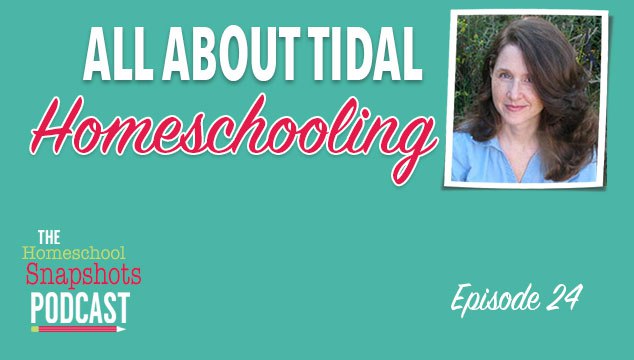
Melissa Wiley is an author and a homeschool mom of 6 who blogs at Here in the Bonny Glen. Her novel, The Prairie Thief, is a big hit at my house, and I have a little Laura Ingalls fan who is just itching to check out her two series of books about Laura’s ancestors, The Martha Years and The Charlotte Years. On this episode of the podcast, Melissa gives us a little peek into her school days and explains her unique philosophy, which she calls Tidal Homeschooling. This interview is full of inspiration for how we can foster an atmosphere of learning, creativity, joy, and relationship-building in our homes by recognizing and working within our own natural rhythms or “tides.” Enjoy!
Click here to listen: HSP 24 Melissa Wiley: All About Tidal Homeschooling – Ed Snapshots
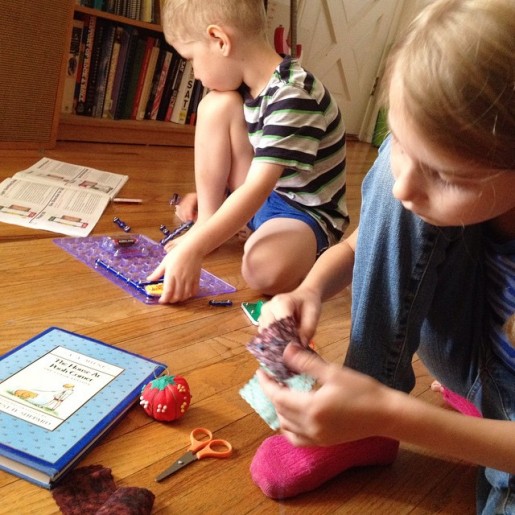
The other day I mentioned that I was putting together some shelves of books to use for Huck and Rilla this year. Huck is 6 1/2, and Rilla is 9, and according to the boxes I will have to check on the form I file in October, they are in the 1st and 4th grades respectively.
(Of course you know we have more of an Understood Betsy approach to grades around here.)
‘What’s the matter?’ asked the teacher, seeing her bewildered face.
‘Why–why,’ said Elizabeth Ann, ‘I don’t know what I am at all. If I’m second-grade arithmetic and seventh-grade reading and third-grade spelling, what grade am I?’
The teacher laughed. ‘You aren’t any grade at all, no matter where you are in school. You’re just yourself, aren’t you? What difference does it make what grade you’re in? And what’s the use of your reading little baby things too easy for you just because you don’t know your multiplication table?’
‘Well, for goodness’ sakes!’ ejaculated Elizabeth Ann, feeling very much as though somebody had stood her suddenly on her head.
I don’t think Rilla has any idea what grade she would be in if she went to school…my kids don’t usually pay attention to grade level until they reach an age—usually around 12 or 13—when they want an answer to the question that comes from just about every new adult they encounter.
But back to my booklists. I compiled these selections according to my patented, highly scientific method of Walking Around the House Grabbing Things Off Shelves™. These are books we already own, favorite tomes I have read with the older kids in the past but which my younger set haven’t yet heard or read—due in large part to the abundant inflow of new treasures that have come our way for review. (Oh you guys, I have so many good new books to share.)
I imagine there will be a lot of crossover: Huck will listen in on Rillabook readalouds and vice versa. Both collections also include a good many read-alone possibilities. If you’ve been reading Bonny Glen for a while, then you know that read-alouds are the core of my homeschooling method, especially in the younger years. (But continuing on, you know, into high school. We still read aloud together lots of history, science, and poetry.)
I know a lot of you are as addicted to booklists as I am, so my project this weekend is to type up these collections to share here on the blog. I hope to post them on Sunday or Monday. When they’re ready, I’ll update this post with links.
So what else does high tide look like in my house for ages 6 and 9?
In no particular order:
• Lots and lots of art, especially watercolor painting and Sculpey fun.
I keep watercolors handy on a shelf by the kitchen table for easy access. These days, they are doing a lot with acrylic paints, too—I caught a sale at Michael’s when those little Folk Art bottles were three for a dollar. I grabbed a set of small plastic palettes (six for $2) and filled a jar with our older, more battered brushes. (We reserve the nicer brushes for watercolors.)
I’ve written about this before*, but for watercolor paper I use large sheets I bought in bulk a good many years ago, folded and torn into smaller sizes. And then cheap recycled paper for drawing. Plus everyone has a sketchbook to do whatever they want with.
About 15 years ago (!) I bought half a dozen scratch-and-dent whiteboard seconds from a discount site. We use these as painting boards. Not only do they protect the kitchen table from spatters, but they are large enough that I can stack them on toy blocks to save space while paintings dry.
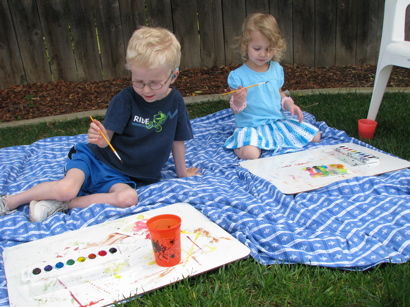
* In that 2009 post, I mentioned that for littles I use good paper and cheap paints. That was back when Rilla was three years old. ::sniff:: Nowadays we tend to experiment with artist-quality tube watercolors quite often, because that is what I myself am learning to paint with, and both Rilla and I are pretty addicted to color-mixing and the way colo. We still keep basic Crayola or Prang kids’ paint sets around, though, like the ones in the photo, because they’re quick and fun and easy and portable. They’re what the kids use for casual, everyday painting.
Kortney has been posting some wonderful resources for doing art projects with kids. And I have a list of my best suggestions in this post.
• Poetry every day
I pulled some of my favorite anthologies for this year’s Huck and Rilla shelves. They’re also in the room for a good bit of the poetry reading and discussion I do with the older kids. I work in lots of opportunities for low-pressure memorization (if you read the same poem out loud a few days or weeks in a row, before you know it, everyone has it down)—including my recent brainstorm to require Huck to learn a new poem by heart before he gets a new iPad app. 
• Handwriting practice* with fun materials like dip pens or slates-and-chalk.
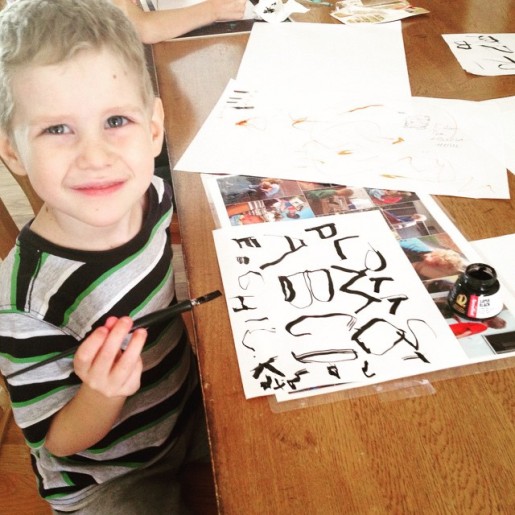
I asterisked practice because I need to qualify that term. I subscribe to the John Holt school of thought about the misleading way we often use the word practice. He argued that when you are doing what we call “practicing” piano, you are really playing piano and we ought to think of it like that. You are making music. When I am “practicing” drawing, I am actually drawing. Huck is learning to write. When he sits down with a marker or crayon and makes some letters, he is writing—not some separate intermediate activity that leads up to writing. I think that word “practice” can set up a feeling that what I’m doing right now isn’t real, it doesn’t count. But it all “counts.” If you’re doing it, it’s real. Another way of putting it is that writing letters to friends is a form of handwriting “practice.”
• For Rilla, a third year of group piano class
And yes, despite the above paragraph, you will from time to time hear me ask her if she has practiced yet today. 
• Nature study and narration.
My old Charlotte Mason standbys. Re narration: casually for Huck, more deliberately and regularly for Rilla. All oral, still. We add written narration at age ten.
Nature study isn’t something we have to work at. Both Rilla and I enjoy adding new plants and bugs to our sketchbooks. You’ll see a fair number of nature-themed nonfiction on both booklists.
• A little bit of foreign language.
Beanie is ramping up her German studies this year. My younger set pick up whatever the older ones are working on, sponge-style.
• Math.
Via games, money, dice, and daily life for Huck; Math-U-See for Rilla. Works for us.
• Folk songs and other musical fun.
Including daddy’s guitar-playing. The recorders seem to have made a comeback around here, too; and Rose came home from her Colorado trip with a pair of ocarinas.
• Baking, sewing, and other handcrafty activities.
Sometimes this is simply a part of daily life; in other cases we may undertake a special project, such as making clothes for a cloth doll with the Dress Up Bunch Club.
• Games of all sorts.
Board games, word games, Wii games, iPad apps, you name it. Together or alone. And lots and lots of Minecraft.
• As much outdoor play as possible!
All the small fry on the block seem to congregate at my house in the afternoons: they know when my kids get their Wii time.  Afterward, they troop outside to bike and scooter and make secret hideouts and chat with passing dogs and help Miss-Joanie-down-the-block rake leaves. (She’s a treasure. She keeps a stash of child-size yard tools in her garage! She saves all those little stickers and calendars and bookmarks that come in junk mail! She has cups labeled for all the kids on our street and sometimes mixes up fruit drinks to fill them with instead of water. Everyone should be so lucky as to grow up down the block from Miss Joanie.)
Afterward, they troop outside to bike and scooter and make secret hideouts and chat with passing dogs and help Miss-Joanie-down-the-block rake leaves. (She’s a treasure. She keeps a stash of child-size yard tools in her garage! She saves all those little stickers and calendars and bookmarks that come in junk mail! She has cups labeled for all the kids on our street and sometimes mixes up fruit drinks to fill them with instead of water. Everyone should be so lucky as to grow up down the block from Miss Joanie.)
• What about history and science?
See above re: readalouds and narration. Lots of good stuff on our booklists. 
And if I don’t stop gabbing and start compiling, these booklists are never going to get written. More later, my dears. Feel free to fire away with questions below, if you have any!
Quick note to say I’ve updated my Tidal Homeschooling page. Are there any questions or topics you’d like me to tackle?
Every morning around nine o’clock, I finish my breakfast smoothie and call the girls to join me in the living room. “Time to start our day,” I say, although really the day’s been chugging along for hours already—I’m up around six, joined early by sleepy boys; at 7:45 I walk Wonderboy around the corner to school, and then Scott and I take a long morning walk; around 8:30 Scott whips up the smoothies and I sit down to sip mine while catching up on email and Facebook.”Start our day” means, during high tide, “start the high-tidish part of the day with some Spanish or something.”
So just now, as always, I announce it’s time to start our day. As I say this, I’m carrying some dishtowels through the house to the laundry pile. I pass through Jane’s room (there’s a hallway right through it): she looks at me quizzically over the top of her laptop; she’s in the middle of a PSAT practice test online.
I poke my head into the room shared by the other three girls, ready to nudge Rose. She’s perched at the table beside Rilla, making a doll. Handstitching two felt doll forms from a kit I’ve had on the shelf for, I dunno, four or five years? Rilla, all smiles, watching her progress, thinking up names. (She’s leaning toward Susie K.)
In the living room, Beanie is deep in the final Harry Potter book: her first time reading it. We take series-finishing VERY seriously around here: no way I’m interrupting that business.
Huck is playing a Sesame Street game on the patio-room computer.
Scott’s hard at work on something superheroish in his office, aka the boys’ bedroom.
Um, yeah, I guess this day is already well underway.
In no particular order, some books and links we’ve been enjoying this week:
Adam of the Road. Newbery-winning middle-grade novel by Elizabeth Janet Gray. We’re only on chapter three so I haven’t much to share about it yet, but it’s delightful so far. Young Adam’s father is Roger the minstrel, and Roger has been off at a respected minstrel school in France while Adam’s attending school at St. Alban’s. And now Roger’s coming back, and I’m guessing from the title that Adam’s hopes will be fulfilled and he’ll be accompaning his father on a journey. Loads of good rich detail here, including, in today’s chapter…
“Sumer Is Icumen In,” a very old English round which I remember learning in a college poetry class. We had to memorize it in Middle English. (I can also still recite the opening of The Canterbury Tales, thanks to Prof. Kraus.) The modern English translation of “the bullock sterteth, the bucke verteth” had, naturally, my nine- and twelve-year-old daughters in hysterics. Scatological humor has no statute of limitations.
I only knew it as a poem, not a musical round, so of course we had to turn to YouTube for help. Here’s a pretty rendition, and here’s a sound file with sheet music for two parts.
Beanie reread the St. Alban chapter of Our Island Story to refresh her memory of that tale, since the book opens on the feast of St. Alban in the town of St. Albans. On a walk, Adam and his friend Perkin pass the crumbling remains of the old Roman buildings from centuries past, and we found pictures of these at Wikipedia.
We’ve been reading bits of Gombrich’s A Little History of the World as well as sections of The Rule of St. Benedict. I looked all over for our copy of The Sailor Who Captured the Sea, a lavishly illustrated picture book that tells the story of the Book of Kells, but it hasn’t turned up yet. (We read it a few months back, though. It’s around somewhere.) Sister Wendy’s The Story of Painting has a nice section on the Book of Kells and the Lindisfarne Gospels.
We keep returning to this Society for Creative Anachronism Flickr pool for illuminated manuscripts. I am repeatedly astonished by the lovely things people can make. Beanie shares my fascination and is eager to try some of the tutorials at the Gutenberg School for Scribes, another SCA gem.
I had the pleasure of seeing this scroll (scroll down, no pun intended) up close in real life at our visit to Sandra Dodd’s house in Albuquerque last month. It’s a marvel. (I am still kicking myself for forgetting to take pictures during that visit. It was a good lesson for me—I kept my camera close at hand for the whole rest of the trip!)
Yesterday, by chance, Rilla pulled Barbara Cooney’s picture book Chanticleer and the Fox off the shelf, based of course on the Chaucer tale. We meant to read that (again) today but we got distracted by our old timeline, the one Jane and I began in New York in the year 2000 and which graced our wall for the four years we lived in Virginia, filling up with colorful entries. It has been in a roll on top of a cabinet the whole time we’ve lived here in California because I couldn’t find wall space for it. Too many bookcases! But today it occurred to me that it would fit in the living room/dining room if we stretched it

By:
Melissa Wiley,
on 9/10/2009
Blog:
Here in the Bonny Glen
(
Login to Add to MyJacketFlap)
JacketFlap tags:
Books,
Connections,
Fun Learning Stuff,
rabbit trails,
Tennyson,
Tidal Homeschooling,
Arthur Ransome,
Swallows & Amazons,
Winter Holiday,
Add a tag
What we read today (an excerpt; “the astronomer” is a boy named Dick, who is stargazing with his sister, Dorothea):
“Got it,” he said. “Just over the top of the hill. Come and see it.”
Dorothea joined him. He pointed out the bright Aldebaran and the other stars of Taurus, and offered her the telescope.
“I can see a lot better without,” said Dorothea.
“How many of the Pleiades can you see?”
“Six,” said Dorothea.
“There are lots more than that,” said Dick. “But it’s awfully hard to see them when the telescope won’t keep still. How far away does it say the Pleiades are?”
Dorothea went back to the fire and found the place in the book.
“The light from the group known as the Pleiades (referred to by Tennyson in ‘Locksley Hall’)…”
“Oh, hang Tennyson!”
“The light from the group known as the Pleiades reaches our planet in rather more than three hundred years after it leaves them.”
“Light goes at one hundred and eighty-six thousand miles a second,” said the voice of the astronomer in the darkness.
But Dorothea was also doing some calculations.
“Shakespeare died 1616.”
“What?”
“Well, if the light takes more than three hundred years to get here, it may have started while Shakespeare was alive, in the reign of Queen Elizabeth, perhaps. Sir Walter Raleigh may have seen it start…”
“But of course he didn’t,” said the astronomer indignantly. “the light of the stars he saw had started three hundred years before that…”
“Battle of Bannockburn, 1314. Bows and arrows.” Dorothea was off again.
But Dick was no longer listening. One hundred and eighty-six thousand miles a second. Sixty times as far as that in a minute. Sixty times sixty times as far as that in an hour. Twenty-four hours in a day. Three hundred and sixty-five days in a year. Not counting leap years. And then three hundred years of it. Those little stars that seemed to speckles a not too dreadfully distant blue ceiling were farther away than he could make himself think, try as he might. Those little stars must be enormous. The whole earth must be a tiny pebble in comparison. A spinning pebble, and he, on it, the astronomer, looking at flaming gigantic worlds so far away that they seemed no more than sparkling grains of dust. He felt for a moment less than nothing, and then, suddenly, size did not seem to matter. Distant and huge the stars might be, but he, standing here with chattering teeth on the dark hill-side, could see them and name them and even foretell what next they were going to do. “The January Sky.” And there they were, Taurus, Aldebaran, the Pleiades, obedient as slaves…He felt an odd wish to shout at them in triumph, but remembered in time that this would not be scientific.
—from Winter Holiday by Arthur Ransome,
one of the Swallows & Amazons books
Where it took us:
* We read the opening of “Locksley Hall,” a long and complex poem which I enjoyed thinking my way through later in the day. With the kids, I read and discussed the first several stanzas, all of us lingering especially over:
Many a night from yonder ivied casement, ere I went to rest,
Did I look on great Orion sloping slowly to the West.
Many a night I saw the Pleiads, rising thro’ the mellow shade,
Glitter like a swarm of fire-flies tangled in a silver braid.
* Of course after that we had to see the Pleiades. Discovered Google Sky. Oh. My. Goodness. Truly, we live in an amazing age.
* Spent a long time playing with Google Sky, looking up many constellations including all those mentioned in the Winter Holiday chapter. Rose told me the story of Orion being chased by the serpent, and we read the legend of the Pleiades, those seven sisters, daughters of Atlas. Beanie fetched D’Aulaire’s Greek Myths because both she and Rose wanted to read me several relevant passages.
* Hunted up our copy of Rey’s Find the Constellations and read about the different magnitudes of stars, among other things.
* Rose found Sirius, the Dog Star, her favorite star, says she, because she loves Diana Wynne Jones’s fantasy novel, Dogsbody, so.
“Here about the beach I wandered,” Tennyson’s poem continues, “nourishing a youth sublime / With the fairy tales of science, and the long result of Time…”
Yeah, that’s the ticket.









 Afterward, they troop outside to bike and scooter and make secret hideouts and chat with passing dogs and help Miss-Joanie-down-the-block rake leaves. (She’s a treasure. She keeps a stash of child-size yard tools in her garage! She saves all those little stickers and calendars and bookmarks that come in junk mail! She has cups labeled for all the kids on our street and sometimes mixes up fruit drinks to fill them with instead of water. Everyone should be so lucky as to grow up down the block from Miss Joanie.)
Afterward, they troop outside to bike and scooter and make secret hideouts and chat with passing dogs and help Miss-Joanie-down-the-block rake leaves. (She’s a treasure. She keeps a stash of child-size yard tools in her garage! She saves all those little stickers and calendars and bookmarks that come in junk mail! She has cups labeled for all the kids on our street and sometimes mixes up fruit drinks to fill them with instead of water. Everyone should be so lucky as to grow up down the block from Miss Joanie.)